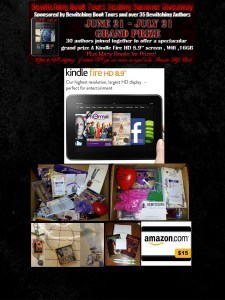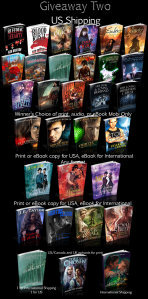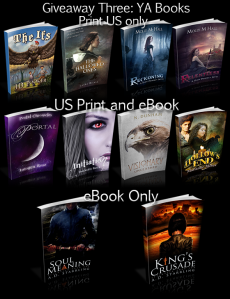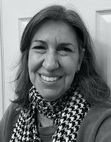Meredith Allard's Blog, page 37
August 5, 2013
Do You Need to Travel to the Place You’re Writing About?
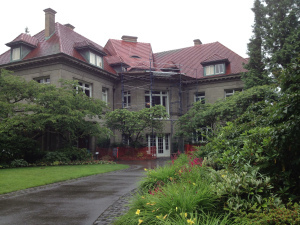
Pittock Mansion in Portland, Oregon
You don’t need to travel to the place you’re writing about, but it’s helpful to go if you can.
Sometimes traveling for research happens by accident, when you find a jewel you didn’t know you were looking for. That’s what happened to me when I was in Portland, Oregon and I found my way to Pittock Mansion. It is a mansion indeed, nestled in the West Hills 1000 feet above Portland with a panoramic view of the city. I’m starting a new novel that will combine a story idea I’ve been kicking around for years with inspiration from my new obsession—Downton Abbey (I know—I’m about three years late to the Downton Abbey party). When I was in Portland I saw something about Pittock Mansion and I knew I had to visit. That afternoon I found myself standing in an old house that echoes the grand English house in Downton, as much as a frontier American house can. I had assumed that Highclere Castle, brilliant in its role as Downton Abbey, was hundreds of years old, but, based on what I found on the website, the mansion has stood in its current incarnation only since 1878 when the interior modeling was completed. I say only since 1878 because, having visited Westminster Abbey in London, I now think everything in Britain is 1000 years old. That makes the current version of Highclere Castle 36 years older than Pittock Mansion, which was completed in 1914. And the two houses might as well be kissing cousins since they have so much in common.

The library at Pittock Mansion
Unlike Downton’s Lord Grantham, Henry Pittock was, first, an actual person, and second, a self-made man. He was English born, Pittock, arriving in America at 19 “barefoot and penniless” (his words). Eventually, he took over the local newspaper, The Oregonian, then the Weekly Oregonian, and in time built an empire while becoming a wealthy man. His house, Pittock Mansion, stands on 46 acres of land, and it’s complete with glorious gardens, a greenhouse, and a servants’ residence. I realized, as I stood in the house admiring the opulent furnishings, pondering antiquated appliances, walking upstairs to the family’s living area, then visiting downstairs to where the servants worked, that wandering around Pittock Mansion was more than a tourist activity. It was a chance to do some research, to stand in a grand house, to see the wide, winding staircase, to feel the sunlight (more like cloudlight than sunlight in Portland) in the open, airy rooms. I won’t be writing specifically about Pittock Mansion, but now I have a personal experience with a grand house that will help me when I sit down to describe one.

The kitchen at Pittock Mansion
There are many articles out there on how to write about a place you’ve never been. Here’s a good one from The Creative Penn. I never used to think much of traveling for research, and for a long time I was content writing about places I had never been. I have an active imagination, as fiction writers do, and I felt that with photographs, maps, Google Earth, and some explanatory information I was able to visualize the place in my mind. Then, after I could see the place clearly, I could describe it in my story. I’ve written about southeastern Georgia, Nazareth, Jerusalem, New York City, and Salem, Massachusetts without setting foot in any of those places. Finally, when I was writing Her Loving Husband’s Curse, I made the decision to visit Salem. I felt like I had used up whatever I learned about the town writing Her Dear & Loving Husband, and for Book Two in the series I needed more to say. That trip was eye opening for me. It showed me that there’s something to be said for standing in the places I’m going to be describing. You can read about my trip to Salem here.
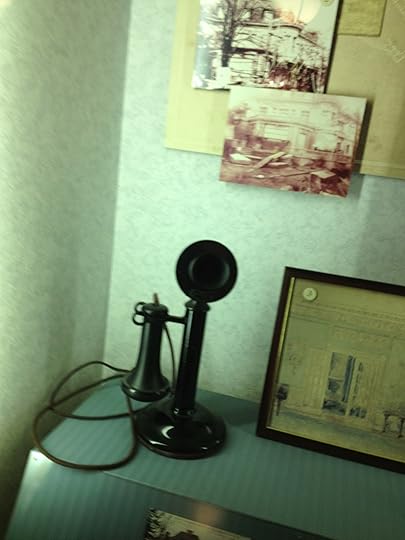
Now whenever I see one of these I think of Mr. Carson practicing his answer.
In On Writing Well, in Chapter 13 “Writing About a Place,” William Zinsser says that “next to writing about people, you should know how to write about a place” (94). He’s talking about nonfiction writing here, but a lot of what he says applies to fiction too. Every story, whether it’s true or make-believe, happens somewhere, and it’s the writer’s job to make that somewhere come to life. Zinsser warns writers to avoid cliches when describing places, and it’s so easy to fall into that trap, using phrases we’ve heard before. Visiting the places I’m writing about helps me avoid those pesky cliches. That’s not to say I never use them (I’m guilty of using the word “quaint,” which Zinsser says is a no-no), but having stood in Salem along the seashore, having walked up a grand marble staircase in a century-old house, I know now how I feel being there. I notice details specific to the area that can’t be found in a brochure or spotted on Google Earth. I’m able to make my descriptions personal—descriptions that only could have come from me—because I was there, I saw it, I walked it, I heard it, I imagined it. I can read about the weather all I want, but experiencing it myself makes it easier for me to share what I know. I’ve learned that experience is language; in other words, experiencing something opens me up and allows me to find the language to express it. Specific street names, monuments, places of interest—those details can be found online. But standing there, seeing it for myself, taking pictures to remember what I saw when I get home, there’s nothing like it.
It’s not always possible to travel for research purposes, and many writers have successfully written about places they’ve never been. But I’ve learned that if you can go, go. The more you feel as though you’ve experienced what you’re going to be writing about, the easier it will be to share with your readers. I know my afternoon at Pittock Mansion will help me when I sit down to write my next novel. My trip to London earlier this year, and my trip back to the U.K. next year, will also help me bring my story to life. So now, whenever I can, I travel to the places I’m writing about. If nothing else, it’s an excuse to see the world.
By the way, Downton fans will love Pittock Mansion. If you’re going to be in the Portland area, check it out.
Filed under: Historical Fiction, Writing Tagged: creative writing, Highclere Castle, On Writing Well, Oregon, Pittock Mansion, Portland, Writing about a place

July 22, 2013
James Wentworth, and What Does it Mean to be a Vampire?
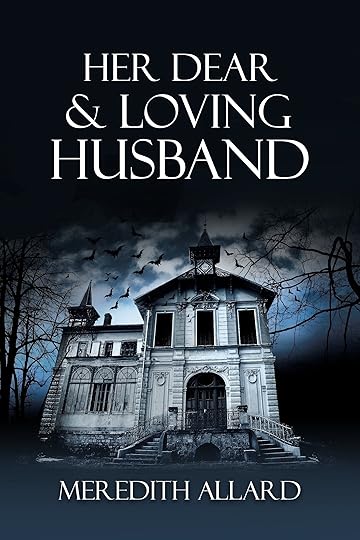 In my Loving Husband Trilogy, James Wentworth is a vampire. But what does it mean to be a vampire?
In my Loving Husband Trilogy, James Wentworth is a vampire. But what does it mean to be a vampire?
On the surface, it’s an unnecessary question since with the popularity of vampire stories everyone seems to have their own ideas of the undead. Yet it’s a question writers of vampire fiction must contend with, and it’s one question I had never considered before sitting down to write the trilogy.
I had never given much thought to vampires. I was never into the paranormal genre, the main reason being I’m not a fan of horror. I’m not a fan of violence, real or pretend, and since vampires have traditionally represented violence, I didn’t care to know them. But then I was introduced to the vampire genre in a less gore-filled way, and the more I read about them the more I realized that there is no one way to describe a vampire. The question of ‘What is a vampire?’ is answered differently according to what authors want or need from their preternatural characters. What a grand revelation as I embarked on my own paranormal stories.
I realized I had a decision to make. Would I go the more traditional route and keep my vamplings asleep during the day, unable to go out in the sun, or would I take the more modern route of sunbeams and sparkles? In the beginning, I had no idea. I hopped on the computer (God bless the Internet) and searched vampire folklore to see how the undead have been traditionally defined. I was fascinated by what I found. Turns out that vampire legends have abounded for as long as there have been people to tell them, long before vampire stories were ever published. Who knew? There are vampire legends from all over the world, and while there are cultural differences, there were more than a few commonalities, and this is what I focused on—the commonalities.
So what is a vampire to me? How did I craft James’s vampire nature?
I tended to stay along more traditional lines. One similarity between almost all vampire legends is that they’re nocturnal creatures. James is as well, sleeping during the day and living at night. He drinks blood. Now, how he choses to drink blood differs from other vampires, but let’s say that he does drink human blood. Their human bodies die as they are transformed (by the bite of another vampire) into a preternatural, immortal being. Again, pretty traditional. As to garlic and silver, well, I don’t know what to say about that. It’s true that traditionally (especially in the Slavic cultures) those are considered supreme weapons against the undead, but it seems to me that if you can live forever a little plant bulb or metal won’t harm you much. But that’s just me. Geoffrey, James’s “maker” (as they would say on True Blood), tends to agree. And since, as a vampire, James lives forever, he loves forever, which is the focus of the trilogy—how he has never forgotten his one true love and the joy he feels when he’s finally reunited with her. On the surface, the Loving Husband Trilogy is a vampire story, complete with witches and werewolves, but it’s really a love story that spans the ages.
Part of the fun of writing in the paranormal genre is the ability to create your fantasy creatures however you want. If you want your vampire sitting on the sofa in broad daylight eating pizza (as Aidan did in the BBC series Being Human), then do it. There is no right way to create a vampire. As long as authors believe that the world they’re describing is true, then readers will follow. What is a vampire? The fun part is, we all get to decide for ourselves.
Filed under: Her Dear & Loving Husband, Her Loving Husband's Curse, Her Loving Husband's Return Tagged: Her Dear & Loving Husband, James Wentworth, Loving Husband Trilogy, vampires

July 19, 2013
Books Are Dead? Not While Powell’s Lives.
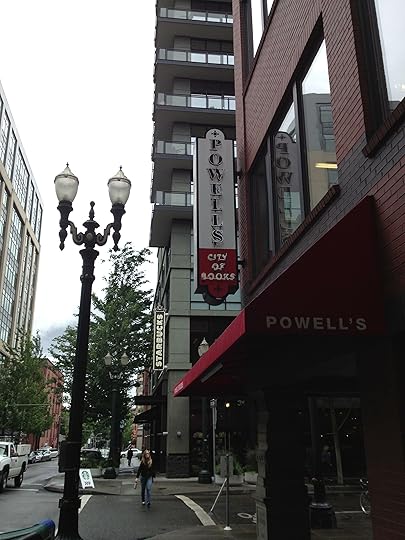
The amazing Powell’s City of Books. Every city needs one.
Today I saw an empty store where a Borders used to be, and I sniffled when I realized the building is now a Ross Dress-For-Less. I have nothing against Ross Dress-For-Less—I found some cute luggage there once—but as I drove past I found myself thinking that, while the world is a sadder place with fewer bookstores, we would survive all right without another half-off department store. I know there are hobbiest bargain shoppers out there who want, no, need more discount stores, but I’d still rather see a bookstore.
During my recent trip to Portland, Oregon, I went, as all book lovers must, to pay homage at Powell’s City of Books, an independent bookstore in Downtown Portland. I’ve known about Powell’s for years. Friends who visited Portland told me about Powell’s. I had read about the store on the Internet. I started following @Powells on Twitter. I hadn’t even been there when I started following them, but for someone who loves history as much as I do, I couldn’t resist following such a relic—an independent bookstore. When I knew I was going to Portland, Powell’s was the first stop on my to-do list.
I don’t know what I expected to see when I walked into Powell’s. Having read all about the death of books, I thought maybe I would find a dilapidated cellar with a few books hanging by their threadbare bindings from a cobweb-covered shelf, the scent of mold and mortality heavy in the air. Or maybe I would find a zombie apocalypse, where hundreds of undead, grunting and groaning as they dragged their corpses across the rotting wooden floor, would wave disintegrating hardcovers and paperbacks in the air and yell, “See! Look what you have done!”
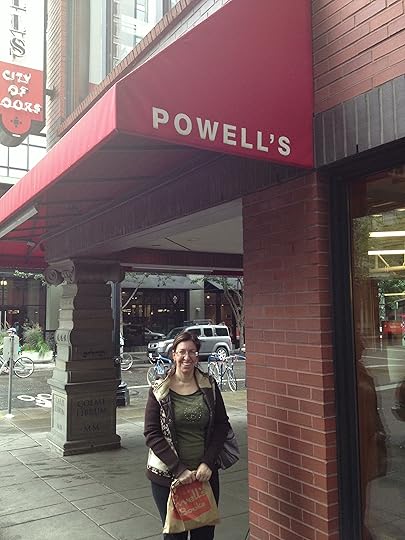
Proof positive: that’s me in front of Powell’s!
Instead, inside Powell’s I saw people—living, breathing people, and a lot of them. They were ordinary-looking folks. They didn’t have two heads or ten eyes. They were boys and girls, men and women, tall and short, doing regular bookstore stuff, pulling books from the shelves, flipping through them, reading the back covers and the insides, putting back the ones that didn’t strike them and holding onto the ones they liked. Some people asked questions of the knowledgeable staff. Even children were reading in the well-stocked, fun-looking young person’s section. I saw a line of people waiting to spend their money, and I couldn’t believe my eyes when I saw they were buying books with that money. And as for the people behind the register…they had the audacity to smile at me while I made my purchase. In other words, the place was thriving. So, I wondered, how has Powell’s held on while other bookstores have faded away?
First, to call it a city of books is an understatement. The place is huge. I read it takes up an entire city block, and having been there I believe it. It has several floors, and each floor is divided into color-coded nooks with every possible category you might want. I was thrilled when I found the ceiling-high shelves of vegetarian cookbooks. I’m so tired of cookbooks with titles like 101 Ways to Cook Rutabagas. I have all the respect in the world for rutabagas, and I’m certain without ever having eaten one that rutabagas are tasty and nutritious. I only mean that even we vegetarians like variety in our diets, and at Powell’s I can find a cookbook to help me. In less-stocked bookstores all I’ll find, if I’m lucky, is something like Vegetables 365 Days a Year and that rutabaga book.
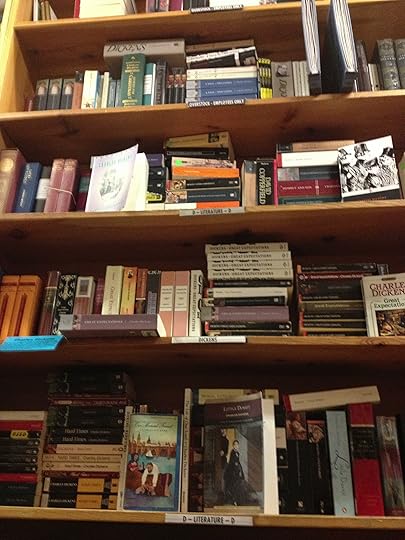
(Insert angels singing here.) The Dickens shelf at Powell’s.
At Powell’s, you feel comfortable enough to browse around and get lost in the stacks. The staff is there if you need them, but otherwise you can look around for hours, which is really all any book lover wants—to find something you didn’t know you were looking for. I found my treasure in the Classics section in the Ds—an entire ceiling-high shelf of Dickens. Every kind of Dickens. Big Dickens and small Dickens. Long Dickens and short Dickens. Popular editions of Dickens and lesser-known versions. Plain text Dickens and illustrated Dickens. Biographies of Dickens. Critical studies of Dickens. The only thing missing, I thought, was Dickens. Not that he’d look all that propped onto a shelf at 201. But still.
Another thing Powell’s does right is buy and sell used books, which gives their customers more variety, more choices. They sell new books at Powell’s too, and I’m all for recently published books, but often there’s something wonderful to be discovered when browsing used books. I didn’t even realize the copy of Wolf Hall by Hilary Mantel I bought at Powell’s was used until I got home and noticed the label. And Powell’s has a thriving website. While the store itself is a fun place to spend time, the Powell’s people haven’t ignored the online world and they understand that sometimes you just want to browse and buy books over the computer while relaxing at home in your jammies. Or maybe that’s me.
I’m glad I took the time to visit Powell’s. I’m glad I got to see actual people reading actual books. I had been believing what I was reading—about how people don’t read any more, how people only skim nowadays, how reading seems boring compared to everything else we could be doing, how there are more people writing books than there are people who read them, which is a worrying thought for someone like me who lives to read and write. But never fear. They’re still out there, readers. I saw them myself, pouring over books, scanning the shelves, and looking for their next great read. I feel better already.
Filed under: Tidbits Tagged: books, Oregon, Portland, Powell's City of Books, reading

July 15, 2013
Guest Post from Dennis Milam Bensie
Dennis Milam Bensie was born in the 1960s and raised with traditional values in Robinson, Illinois. Bensie desperately wanted romance, a beautiful wedding, and a baby to carry on the family name. He denied his sexuality and married a woman at nineteen years old, but fantasized of weddings where he could be the bride. The newlyweds “adopted” a Cabbage Patch Doll and ironically witnessed a Cabbage Patch Doll wedding (a successful fundraiser staged by a local women’s club) where the dolls were granted the type of grand ceremony off-limits to gay couples.
In search of his identity as a gay man, Bensie divorced his wife and stumbled through missteps and lessons that still sting his generation: defending against bullies, “disappointing” his parents, and looking for love in gay bars, bath houses and restrooms. He helped his straight friends plan their dream weddings and mourned his gay friends dying of AIDS.
Although true love has not yet come his way, Bensie has learned to love himself. Bensie is the author of the much-lauded memoir, Shorn: Toys to Men, which recounts his battle with paraphilia. One Gay American tells the rest of his story and draws parallels to gay history, decade by decade, with newspaper headlines and quotations. Bensie is the gay neighbor that you either love or hate. Either way, he’s got a lot to say and says it with no apologies.
Here is an excerpt from Bensie’s book One Gay American:
Ribbons: Commitment Ceremony (a.k.a Gay Wedding)
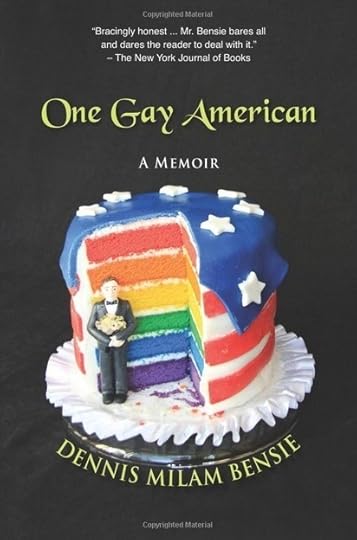 Breaking the Code was a play about British mathematician Alan Turing, who was a key player in the breaking of the German Enigma code at Bletchley Park during World War II. The play thematically links Turing’s cryptographic activities with his attempts to grapple with his homosexuality.
Breaking the Code was a play about British mathematician Alan Turing, who was a key player in the breaking of the German Enigma code at Bletchley Park during World War II. The play thematically links Turing’s cryptographic activities with his attempts to grapple with his homosexuality.
I was doing hair and wigs for a production of the play at Alice B. Theater in Seattle when my friends Matt and Scot first met. Matt was the Assistant Stage Manager and Scot was playing a young street hustler. It was delightful to watch their relationship blossom over the next several months.
Gay activism got even more personal for me when the two of them announced that they were going to make their relationship official and have a commitment ceremony. This would be my first gay wedding, and I was thrilled.
Both sets of parents supported the union and planned to come to town for the event. I was jealous. I doubted that my parents would ever come to a commitment ceremony of mine. They had never even come to Seattle for a visit.
I realized as I watched the guys plan their wedding in detail that there were no established traditions for gay weddings. They could pick and choose what they wanted to do and make the event special for them. Their friends and guests were sure to be open minded enough to love anything they did.
The ceremony was to take place at Aha! Theater, a Seattle fringe theater the couple was involved with. Their invitations paid some homage to tradition, but with their own twist. A friend and aspiring baker agreed to make their wedding cake—a three tier pink triangle cake with two grooms on top. Care was given to make sure the grooms looked like Matt and Scot. They planned a festive reception in the same space with a rented karaoke machine and gay door prizes for the guests.
I was honored to be asked to help the boys select new outfits for ceremony. We had serious discussions about what would work best. Since the wedding wasn’t being held in a church and they wanted to be comfortable, they decided to go with dressy, casual looks. We spent a Saturday shopping downtown and came up with ensembles that looked sharp, but didn’t match or say “wedding.”
I still felt that the boys needed some element of a bride (or at least a bride doll) at the event: a wink at tradition. In 1977, Mattel created a Super Size Barbie that was eighteen inches tall rather than the tradition eleven and one half. In 1992, they introduced My Size Barbie, which stood three feet tall and was sold with a stretchy outfit that, ideally, the doll’s owner would be able to wear and share. Mattel hadn’t planned on a twenty-eight-year-old gay man buying the doll.
I bought a My Size Barbie for myself when she came out on the market. I decided Matt and Scotʼs wedding was the perfect 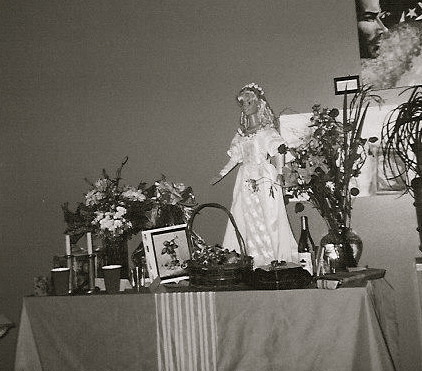 opportunity to indulge my never-ending interest in wedding dresses. I made the My Size Barbie a beautiful wedding dress fit for a queen. The guys loved the doll and the dress and decided the enormous bride doll would look perfect presiding over their gift table at the reception. She was much bigger than my cousin Libbyʼs bride doll, who had presiding over the gift table of her wedding years before. I was touched beyond belief. I was, after all, making a white wedding dress for a gay wedding. Ladyman Dennis would have been proud.
opportunity to indulge my never-ending interest in wedding dresses. I made the My Size Barbie a beautiful wedding dress fit for a queen. The guys loved the doll and the dress and decided the enormous bride doll would look perfect presiding over their gift table at the reception. She was much bigger than my cousin Libbyʼs bride doll, who had presiding over the gift table of her wedding years before. I was touched beyond belief. I was, after all, making a white wedding dress for a gay wedding. Ladyman Dennis would have been proud.
As the big day grew closer, the grooms had plenty of jitters. Jitters turned to deep sadness when a fellow thespian friend named Vinny died of AIDS only a few days before the ceremony. It was a shock that such a sweet and vibrant man, only twenty-five years old, would vanish on the eve of such an uplifting celebration of life and love.
Emotions ran high as Matt and Scot’s wedding day finally dawned. The black box theater space was decorated with gay pride paraphernalia. They had decided to do a variation of the traditional European ritual called Handfasting, symbolizing “tying the knot.” Guests were all given a mysterious piece of ribbon about two feet long (in one of the six colors of a gay pride flag) as they entered and signed the guest book. They were all warned not to lose their piece of ribbon. A round platform about two feet tall had been erected in the middle of the space. People walked around the platform without realizing its purpose. All would be revealed later during the event.
There was a lot of hugging and tears: an odd mix of happiness and sadness. The day had become both a gay wedding and a memorial for our friend Vinny. The timing seemed unreal and unfair. However, as people filed into the theater, I saw that the timing couldn’t be more perfect. Vinny was with us; he was a reminder of how important gay people are. We would never forget Vinny.
I couldn’t help thinking about the play where Matt and Scot met. In Breaking the Code, Alan Turing’s homosexuality resulted in a criminal prosecution. He accepted chemical castration as an alternative to prison. Turing allegedly committed suicide before his 42nd birthday. It seemed appropriate that Matt and Scot met working on a play inspired by his story. In many ways, their ceremony was breaking the code, too.
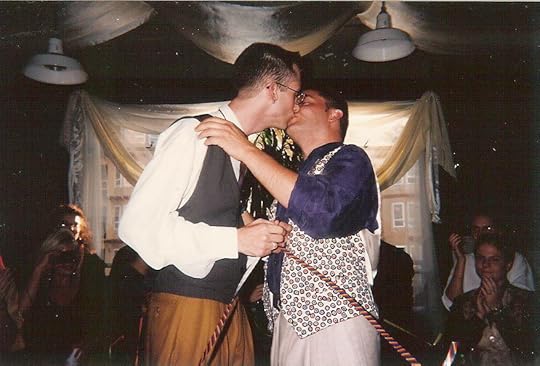 The handfasting ceremony began. Matt and Scot and their parents all got up on the platform in the middle of the room. Close to seventy-five of their friends and loved ones surrounded the platform in a complete circle. Each guest was told to tie his or her ribbon to another guest’s ribbons. The mothers of the grooms tied one end of their ribbons to the guests’ chain. Mattʼs mom then tied her ribbon to Scotʼs ribbon, while Scotʼs mom tied hers to Mattʼs. The men each held one end of the trail of ribbon not yet joined.
The handfasting ceremony began. Matt and Scot and their parents all got up on the platform in the middle of the room. Close to seventy-five of their friends and loved ones surrounded the platform in a complete circle. Each guest was told to tie his or her ribbon to another guest’s ribbons. The mothers of the grooms tied one end of their ribbons to the guests’ chain. Mattʼs mom then tied her ribbon to Scotʼs ribbon, while Scotʼs mom tied hers to Mattʼs. The men each held one end of the trail of ribbon not yet joined.
There was no one officiating the ceremony. My friend Ruth was in charge of sound. On cue, she put a cassette tape in a portable cassette player. A beautiful song, “Stay for the Ride,” underscored the ceremony. The song was by a local lesbian singer, Lisa Koch, from her album Colorblind Blues. Lisa’s song was the perfect accent to the occasion: hauntingly romantic and sincere. Matt spoke first of the difficult week that had begun with the death of Vinny. He began sobbing.
“Today is dedicated to Vinny,” Matt said as the two men tearfully exchanged vows they had written themselves. When the vows were completed, the two grooms tied their end of the ribbon to each other, uniting the room in gay pride colors. The gesture was special and I knew I would never forget the special day as long as I lived.
Finally I understood weddings. I had witnessed what I wanted to see my whole life—two men in love coming together in pride. The dress wasn’t important. Walking down the aisle wasn’t important. Matt and Scot indulged a tradition and no one could convince me they were wrong.
I wished there was a bouquet to toss, one that I could have caught. I loved Matt and Scot so much, but it was hard to contain my jealousy. Two distinct images of gay life: the happy couple and the boy dead of AIDS. I was very scared.
Was I going to die of AIDS that I had caught at a bathhouse while looking for true love?
Matt and Scot kept the yards and yards of tied ribbon from their ceremony in Seattle.
I gave them the My Size Barbie wedding dress to keep as a memento.
One Gay American
Paperback: 242 pages
Publisher: Coffeetown Press (September 1, 2012)
Language: English
ISBN-10: 1603811532
ISBN-13: 978-1603811538
Price $13.95
___________________________________________________________________________________________
Dennis Milam Bensie grew up in Robinson, Illinois where his interest in the arts began in high school participating in various community theatre productions. Bensie’s first book, Shorn: Toys to Men, was nominated for the Stonewall Book Award, sponsored by the American Library Association. It was also a pick in the International gay magazine The Advocate as “One of the Best Overlooked Books of 2011.″ The author’s short stories have been published by Bay Laurel, Everyday Fiction, and This Zine Will Change Your Life, and he has also been a feature contributor for The Good Men Project. One Gay American is his second book with Coffeetown Press and it was chosen as a finalist in the Next Generation Indie Book Awards and the Indie Excellence Book Awards. He was a presenter at the 2013 Saints and Sinners Literary Festival in New Orleans. Dennis lives in Seattle with his three dogs. You can find out more about Dennis Milam Bensie, his memoirs and World of Ink Author/Book Tour at http://tinyurl.com/lhtvxyt. To learn more about the World of Ink Tours visit http://worldofinknetwork.com
Filed under: Guest Authors Tagged: Dennis Milam Bensie, guest posts, One Gay American

July 10, 2013
Illicit Love Blog Tour and Giveaways
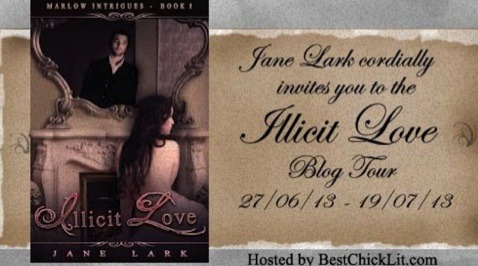
Welcome to Stop Eight on the Illicit Love blog tour! Jane Lark is celebrating her first instalment in the Marlow Intrigues series with a HUGE giveaway – including a one night stay in London’s Regency Hotel, Amazon gift voucher, signed copies of Illicit Love and plenty of swag!
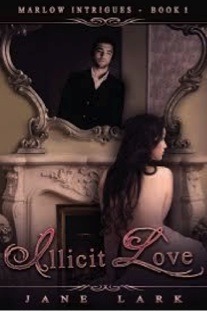 Illicit Love – What they say:
Illicit Love – What they say:
‘Ellen Harding longs to be free of the life she is trapped in – her husband died at the battle of Waterloo and her family disowned her and now she lives under the reign of a cruel protector. When her eyes are drawn to a beautiful man for no other reason than his looks, she imagines escaping her chains for a night by giving her body to him – to a man of her choosing – even if only to infuriate her captor.
But Edward Marlow is kind and gentle when he touches her and her subconscious whispers that this man could save her. Yet how can he help her when she has secrets which prevent her ever being free. She has too many battles to fight.
Edward is restless, lonely and a little angry with his lot in life – it is his only excuse for being drawn to another man’s mistress. The woman’s dark hair and pale eyes are striking and he cannot take his gaze off of her while she watches him over the top of a fan with an illicit intent in her eyes. But once he’s known her he cannot forget her – and once he’s seen how brutal her protector is, how can leave her with the man? But she will not run anymore than she will speak of her past, so how can he help her…’
Click Here To Buy This Book – UK
Click Here To Buy This Book – US
Check Out Jane’s New Novella Available At Amazon:
Captured Love – What they say:
‘Rupert Stanforth, Earl of Morton, is missing his cousin’s company. He has too many burdens weighing down his shoulders,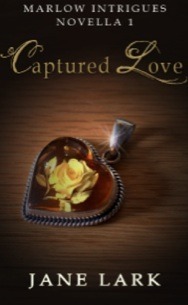 including the task of finding his sister, Rowena, a husband.
including the task of finding his sister, Rowena, a husband.
Meredith Divine has one friend in all the world, Lady Rowena Stanforth. She clings to their friendship as though it is a rope, when she is drowning in a lake of social isolation. Even Rowena’s elder brother cannot stand Meredith. Everyone judges her poorly, simply because her father is in trade. But despite Lord Morton’s constant rejection, Meredith’s heart still favors Rowena’s proud, judgmental brother.
Lord Morton would break the friendship his sister has with Miss Divine if he could, but the more he disparages Miss Divine, the more Rowena favors the girl. He’s ceased his complaints, in the hope the friendship would wither and die, believing the girl would make a wrong step soon. He just did not anticipate what that step might be…’
Click Here To Buy This Book – UK
Click Here To Buy This Book – US
Video Interview with Author Jane Lark
Here are the Giveaways!
Want To Win A Night In London’s Regency Hotel?
 The Regency Hotel has been kind enough to support the Illicit Love blog tour by donating a one-night stay for two
The Regency Hotel has been kind enough to support the Illicit Love blog tour by donating a one-night stay for two lucky winners this August! Located in the Royal Borough of Chelsea and Kensington, you could find yourself relaxing in one of hotel’s plush new bedrooms or sampling the delights of their incredible traditional afternoon teas.
lucky winners this August! Located in the Royal Borough of Chelsea and Kensington, you could find yourself relaxing in one of hotel’s plush new bedrooms or sampling the delights of their incredible traditional afternoon teas.
Readers have plenty of chances to win:
 Either entry via the Rafflecopter below AND/OR add your review of Illicit Love to Amazon and Goodreads and email the review link to Charlotte@BestChickLit.com.
Either entry via the Rafflecopter below AND/OR add your review of Illicit Love to Amazon and Goodreads and email the review link to Charlotte@BestChickLit.com.
The winner will be emailed a voucher, which can be redeemed for stays during August 2013 only. Giveaway closes 19th July 2013.
Here is the link for the Rafflecopter Giveaway.
Win £30 (or $40) Amazon Gift Voucher!
 Entry via the Rafflecopter below AND/OR add your review of Illicit Love to Amazon and Goodreads and email the review link to Charlotte@BestChickLit.com. Giveaway closes 19th July 2013 and is open to UK and USA residents only.
Entry via the Rafflecopter below AND/OR add your review of Illicit Love to Amazon and Goodreads and email the review link to Charlotte@BestChickLit.com. Giveaway closes 19th July 2013 and is open to UK and USA residents only.
Here is the link to the Rafflecopter Giveaway.
Win One Of Three Swag Packs With Signed Paperback Copy of Illicit Love
Entry via the Rafflecopter below AND/OR add your review of Illicit Love to Amazon and Goodreads and email the review link to Charlotte@BestChickLit.com. Giveaway closes 19th July.
Here is the link to the Rafflecopter Giveaway.
About the Author:
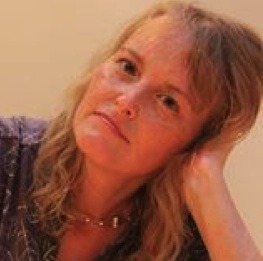 Jane is a writer of authentic, passionate and emotional love stories. She began her first historical novel at sixteen, but a life full of adversity derailed her as she lives with the restrictions of Ankylosing Spondylitis. When she finally completed a novel it was because she was determined not to reach forty still saying, I want to write. You might think that Jane was inspired to write by Jane Austen, especially as she lives near Bath in the United Kingdom, but you would be wrong. Jane’s favourite author is Anya Seton, and the book that drew her into the bliss of falling into historical imagination was ‘Katherine’ a story crafted from reality. Jane has drawn on this inspiration to discover other real-life love stories, reading memoirs and letters to capture elements of the past, and she uses them to create more realistic plots. ‘Basically I love history and I am sucker for a love story. I love the feeling of falling in love; it’s wonderful being able to do it time and time again in fiction.’ Jane is also a Chartered Member of the Institute of Personnel and Development in the United Kingdom, and uses this specialist understanding of people to bring her characters to life. Check out Jane’s musical inspirations HERE and HERE.
Jane is a writer of authentic, passionate and emotional love stories. She began her first historical novel at sixteen, but a life full of adversity derailed her as she lives with the restrictions of Ankylosing Spondylitis. When she finally completed a novel it was because she was determined not to reach forty still saying, I want to write. You might think that Jane was inspired to write by Jane Austen, especially as she lives near Bath in the United Kingdom, but you would be wrong. Jane’s favourite author is Anya Seton, and the book that drew her into the bliss of falling into historical imagination was ‘Katherine’ a story crafted from reality. Jane has drawn on this inspiration to discover other real-life love stories, reading memoirs and letters to capture elements of the past, and she uses them to create more realistic plots. ‘Basically I love history and I am sucker for a love story. I love the feeling of falling in love; it’s wonderful being able to do it time and time again in fiction.’ Jane is also a Chartered Member of the Institute of Personnel and Development in the United Kingdom, and uses this specialist understanding of people to bring her characters to life. Check out Jane’s musical inspirations HERE and HERE.
Get In Touch With Jane:
Filed under: Giveaways, Guest Authors Tagged: BestChickLit, Blog Tour, Giveaways, guest authors, Illicit Love, Jane Lark

July 8, 2013
An Interview With Author M. Louisa Locke
Here is my interview with author M. Louisa Locke for The Copperfield Review. Locke is the author of the Victorian San Francisco Mystery series and a trusted authority on independent publishing. The first book in the Victorian San Francisco Mystery series is Maids of Misfortune, and the sequel is Uneasy Spirits, both bestsellers in the historical mystery category on Kindle. Maids of Misfortune is a 2012 B.R.A.G. MedallionTM Honoree.
Meredith Allard: When and why did you begin writing, and did you always write historical fiction?
M. Louisa Locke: I knew I wanted to write historical fiction by the time I reached high school. Books had played an enormously important role in my life growing up, and historical fiction was already my favorite. When I attended college in the late 1960s, however, I realized that if I had to have a day job (I assumed that writing wouldn’t support me) I would rather be a professional historian than a professor of English literature. I went ahead and got a doctorate in history, but while doing the research for my dissertation, I found myself daydreaming about writing a series of mysteries that would feature the different jobs women held in the late Victorian era.
In 1989, between teaching jobs, I decided to give writing a chance as a means of support, and I wrote the first draft of what was to become Maids of Misfortune. Annie Fuller, my protagonist, makes money by running a boarding house (a common occupation for widows like Annie), but she also supplements her income giving business advice as a pretend clairvoyant (again, a frequently held female occupation at the time.) In this first book, Annie also goes undercover to work as a domestic servant, the most prevalent job for women in the nineteenth century.
Soon after I completed this first draft, I not only received a series of rejections from publishers but I also got a full-time job as a history professor at San Diego Mesa College. Writing again took a back seat. Twenty years later, when I semi-retired from college teaching, I picked up the manuscript, rewrote it extensively, and published it as both a print and an ebook. The sales on Maids of Misfortune were so strong that I was able to retire completely to become a full-time writer, publishing Uneasy Spirits, the second book in my Victorian San Francisco Mystery series, in 2011. I plan to publish the third book, Bloody Lessons, in the early Fall, 2013. It may have taken me 50 years, but I finally am realizing my childhood dream of writing historical fiction!
M.A.: On your website you mention that you did your Ph.D. dissertation on the late nineteenth century western working woman. Your historical mystery novels are also set around the same time. What brought about your fascination with the western working woman?
M.L.L.: I think that the late 19th century fascinated me because of the parallels I saw to my own generational experience (I was born in 1950 and grew up squarely in the middle of the sixties social movements.) The Civil Rights movement, the women’s movement, and the demand for political reform that came out of Watergate all had their counterparts in the 19th century. In both eras, there were strong pressures to keep women confined to the role of wife and mother. Yet, in both time periods there were women who challenged those traditional ideals.
In the late 1970s, I was studying to become a history professor when less than 20% of all history professors were women, so I was surprised to learn in my research that women had held a higher proportion of professional jobs a hundred years earlier than they did when I was growing up. I wanted to know about these women and the choices they made, so I did a statistical analysis of women who held income-producing occupations based on the 1880 Federal manuscript census. I chose to study women in San Francisco, Los Angeles, and Portland because I lived on the west coast and most of the research on working women had focused on eastern cities. Naturally, when I started to think about writing fiction, I turned to the women I had been studying. They had become very real to me, and I wanted to make them come alive to others.
M.A.: I love to read mystery novels, but I have yet to try to write one. What are the particular challenges of writing mystery?
M.L.L.: As with most genre novels, there are certain conventions that you need to keep in mind when writing mysteries. Even if you disobey those conventions (for example, don’t have a body in the first chapter) it needs to be for a good reason. Otherwise, you can lose your reader. People who read mysteries expect that there be some sort of puzzle that is going to be solved. The puzzle can be a death or some other crime, and the person who solves the mystery can be a professional or an amateur. But as a mystery author, you need to know what that crime is (what was done), have developed some red herrings (people who might have done the crime, but didn’t), and eventually provide enough clues so that the reader has a chance to guess who actually committed the crime along side the detective. Then, depending on the sub-genre of mystery, you need to balance those basic mystery plot requirements with effective character development, detailed setting, believable romance, sufficient suspense, etc. I would say that achieving that balance is one of the most difficult tasks any mystery writer faces.
M.A.: You mention in your bio that your first historical mystery novel, Maids of Misfortune, was inspired by a diary entry from a domestic servant, and that you found that diary entry while researching your dissertation. How do you go about researching the history in your stories? Have you traveled for research purposes?
M.L.L.: Since I spent years doing research on San Francisco and the women who worked there in the 19th century, I don’t have to do a lot of new research for my novels. However, the internet has made the supplementary research I do for each story much easier. There are websites that tell you when the sun and moon rose on a given day in 1880, what words were in common usage then, and what a Victorian corset feels like. The main problem is not letting the research suck you in so that you don’t get the words onto the page.
Because the sections of San Francisco that I set my novels in were devastated by the Earthquake and Fire of 1906, I do have to spend a good deal of time looking at old maps and pouring over old photographs to make sure my descriptions are accurate. But I also visit San Francisco frequently, trying to come at the same time of year that the current book is set in to get a feel for the weather, where the sun hits buildings, and so forth. I love walking the streets between the different places in my books, imagining….
M.A.: How would you describe your novels to potential readers? What makes your novels different from others about similar eras?
M.L.L.: Many of the other successful Victorian era mysteries tend to portray the violent and sexually exploitative aspects of 19th century urban culture. They are darker in tone than my books and often have more in common with contemporary thrillers. While my books don’t neglect some of the important issues of the day, for example the extreme anti-Chinese sentiment in the west at this time, my goal from the first was to write historical mysteries that were traditional cozies in style.
Annie’s boarding house reflects the kind of small community you find in a cozy, and there is a strong thread of humor and romance throughout my stories as well. The sex and violence is generally off-stage, and there is even a cute dog. On the other hand, I believe that because my historical mysteries are set in real places, with characters facing real issues of the time period, readers can feel a greater connection to the people in my stories than they may do with the quirky characters found in many contemporary cozies.
M.A.: All authors have a different path as they seek publication. What was your journey to publication like? What can you tell us about the joys and the challenges of being an independent author?
M.L.L.: While I pursued my career as a college professor, I watched as my writer friends were treated in the increasingly hostile environment traditional publishing. As a result, when I decided to give publishing another try in 2009, I was open to considering the opportunities that self-publishing and the ebook revolution were providing. One of the major considerations for my decision to become an indie author was how long it took (and still takes) for a book to make it into print the traditional way. I’d conceived ofMaids of Misfortune thirty years earlier, I’d written it twenty years earlier, and I didn’t want to wait another 2 years or more to get it into the hands of readers. If no one liked it, so be it. At least I would have given it a try.
Once this decision was made, it only took a few months for me to master how to design, and format ebooks and print books, and it took only 24 hours to upload the Maids of Misfortune. Within a day I had my first sale and my first positive review!
I also enjoyed learning the technical and marketing aspects of self-publishing. I am a life-long student, as well as a social scientist and a teacher, so learning how to publish independently, experiment with different marketing strategies, and then being able to share what I have learned with other authors, has simply added to my satisfaction with the process.
I can say without reservation that my decision to self-publish was the best decision I ever made. Besides the fact that my books have been a financial success, every positive review, every letter from a fan, every comment on my Facebook page is pure gold.
M.A.: I was looking at the Historical Fiction Authors Cooperative, and I can’t believe I’m only finding out about it now. It is definitely something readers of Copperfield should know about. How did the Historical Fiction Authors Cooperative come about?
M.L.L.: One of the upsides of the ebook/indie author revolution has been that books like Maids of Misfortune that weren’t making it through the gatekeepers/bottlenecks of agents, publishers and booksellers, are getting published and in the hands of readers. However, the question has become: how is a reader going to be able to sift through all those books and find the right one for them, and how is an author going to make sure their books are visible to the right market?
Book review websites like Copperfield Review is one answer and The Historical Fiction Authors Cooperative (HFAC) is another. HFAC was formed by a group of independent authors who recognized that there was strength in numbers. Behind the scenes we share information on technical issues (like cover design, formatting, getting books into the various ebooks stores like Kindle and Nook), and we help cross-promote each other’s work. All of this helps elevate the quality of our work and its visibility.
But the most important tasks were to recruit great historical fiction authors and design where readers could find our work. The group started less than three years ago with just a handful of authors, but we now grown to 40 members with 140 separate titles in our catalog, which can be found at HFeBooks.com.
M.A.: What can readers who love historical fiction gain from visiting the Historical Fiction Authors Cooperative site?
M.L.L.: A fan of historical fiction can discover on our website high quality historical fiction that they wouldn’t find in traditional bookstores. In some cases the books are out-of-print books our authors have republished, in others, they are new independently published work by authors who are still traditionally published, and in most cases these are books by innovative independent authors.
Because membership in HFAC is by invitation only and we thoroughly vet those members and their work before inviting them, a reader can be assured that the books in our catalog are grounded in accurate historical research, are professionally edited, and well-written. We have listed the books by historical eras, as well, since many fans of historical fiction have favorite periods they like to read about. You can also find out about the author, the other books they have written, and you can read interesting articles by them about their historical research on our blog.
Finally, if you subscribe to the website, you will be alerted every week about discounts and free books that are being offered, as well as when a new book by one of our members is published. Other ways you can be alerted to this information is to follow us on twitter or Facebook.
M.A.: Is there a way historical fiction authors can be considered to be included in the cooperative?
M.L.L.: The vetting process is very slow since at least two members have to read and evaluate an author’s work before extending an invitation. As a result, most of our recruitment comes from recommendations from other members. We also look at those ebooks that are successful in historical fiction categories in ebookstores.
The bottom line is: write high-quality historical fiction, market it well, and, in time, as you gain reader recognition there is a good chance your work will come to our attention.
M.A.: Which authors are your inspiration—in your writing life and/or your personal life?
M.L.L.: Georgette Heyer was my first inspiration. She was a serious historical scholar, but the light romantic Regency novels she wrote are a continuing delight, and for over fifty years I have turned to her books when I need to escape the painful realities of this world. From Dorothy Sayers, and her Lord Peter Wimsey/Harriet Vane mysteries, I learned how to combine romance and crime solving. From Tony Hillerman’s New Mexico mysteries, I discovered that the importance of setting, and Ellis Peters’ Brother Cadfael series gave me the idea of combining historical fiction and mysteries. There are many great contemporary writers who have continued on in these traditions, but these were my first inspirations.
M.A.: What advice do you have for those who want to write historical fiction or mysteries?
M.L.L.: This may seem trite, but it is true. Read. Reread your favorite books in the genres you wish to write in, but do so looking at what worked to make them your favorites. Is it the characters, the plot, the pacing, the background material? Read new books, and here you might find yourself analyzing what doesn’t work for you. Why did you get impatient at some point, never really care for the main character, become confused? Do you seem to like books written in the first person? Third person? Shifting points of view?
If you are pursuing historical fiction, skim through general texts about the period, read autobiographies and contemporary fiction of the time. All of this should give you a general feel for the historical setting. But don’t spend too much time in detailed research until you are actually writing the book. Spending days figuring out what to call the kind of carriage your character might own, before knowing if that carriage will even figure in the story, can be a waste of time. This is the stuff you can fill in later as you go along (or after the first draft is written.)
M.A.: What else would you like readers to know?
M.L.L.: For those who think they might be interested in my work, do check out my website/blog or myFacebook author page. I also have two short stories that feature minor characters from my full-length novels that you might find amusing. They are Dandy Detects and The Misses Moffet Mend a Marriage.
Filed under: Copperfield Review, Guest Authors, Historical Fiction Tagged: Copperfield Review, historical fiction, Indie Authors, M. Louisa Locke, Victorian San Francisco Mystery Series

July 1, 2013
What Do Superman and a Vampire Have in Common?
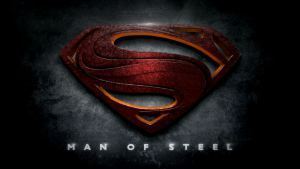
Photo Credit: fansided.com
Probably more than you think…
When I was watching the new Man of Steel movie the other day, the struggles of Clark Kent (aka Superman) reminded me of another fictional character who is especially close to my heart—my own vampire James Wentworth. But what could Superman have in common with a vampire? After all, he’s Superman.
The new Man of Steel movie, or at least the first half of it, is about how Clark Kent struggles through the world knowing how different he is from the humans around him. How does he adapt to those differences? In the film, Clark becomes a wanderer, directionless, hopping from job to job without any real goals, not too sure where he belongs. He overhears conversations he may not want to hear, and then what does he do with the information? How does he stop others from doing bad, and how does he protect those around him without alerting everyone else that he has special powers?
It’s the same struggle James deals with, particularly in Books One and Two of the Loving Husband Trilogy, Her Dear & Loving Husband and Her Loving Husband’s Curse. James is a vampire with extraordinary strength and superhuman senses, and he knows he needs to hide the truth of what he is, that he is undead among the living, to get through his nights without being run out with torches and pitchforks, or whatever it is they would use these days. Unlike Clark and his Kent family, James doesn’t have to speculate about what might happen when humans are confronted with things they don’t understand. James has seen it, he’s lived through it, from the Salem Witch Trials, to the Cherokee expulsion on the Trail of Tears, to the internment of thousands of innocent Japanese-Americans during World War II. He knows all too well how madness infects people when they’re confronted by something new or confusing. So James has kept himself in the darkness, literally and figuratively, wanting to remain part of the human world yet holding himself aloof from it for fear of the hysteria the knowledge of vampires would bring. Both Clark and James are afraid to be themselves. Yet they want to blend in. They want to seem like everyone else.
What is the right thing to do? Is Clark’s adopted father, Jonathan Kent, right to tell his son to wait until the time was right to make his mark on the world? James would be perfectly happy never making his mark anywhere but in his university classes with his students or at home with his beloved wife Sarah. He doesn’t feel destined for greatness, as Jonathan believes Clark is. James doesn’t want the spotlight. All James wants is to help others as quietly as he can and live in peace with his family. In the end, in Book Three, Her Loving Husband’s Return, James makes a great sacrifice to get the life he’s always wanted. Clark has to sacrifice as well as he comes to terms with his destiny as Superman. And also like Superman, James’s struggles only increase as others discover who and what he is.
Both Clark and James are afraid to be themselves for fear of what others will say. Their coming of age stories about how they learn to make peace with their places in the world can be understood by everyone. We are all different in one way or another, which is why coming of age stories are so important—they remind us that no matter who we are we can find a meaningful place for ourselves if we’re willing to try. Whether you’re an alien, a vampire, or whatever you happen to be, you can make peace with yourself and your place in the world. That’s a lesson we all need to learn.
Filed under: Her Dear & Loving Husband, Her Loving Husband's Curse, Her Loving Husband's Return, Tidbits Tagged: Clark Kent, James Wentworth, Loving Husband Trilogy, Man of Steel, Superman

June 28, 2013
Her Loving Husband’s Return is now on tour!
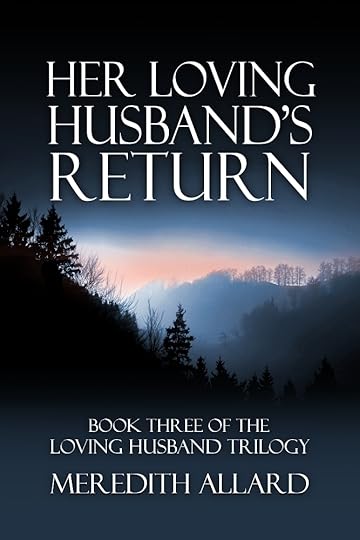 I just got home from a few days in Portland, Oregon, which I loved. And of course I visited Powell’s City of Books. Since I was mainly unplugged, I didn’t have a chance to post the tour dates for the Her Loving Husband’s Return tour, which started on Monday, 6/24. Visit the tour stops and say hello!
I just got home from a few days in Portland, Oregon, which I loved. And of course I visited Powell’s City of Books. Since I was mainly unplugged, I didn’t have a chance to post the tour dates for the Her Loving Husband’s Return tour, which started on Monday, 6/24. Visit the tour stops and say hello!
June 24 Guest blog
Urban Fantasy Investigations
http://urbanfantasyinvestigations.blogspot.com/
June 25 Spotlight
Sapphyria’s Book Reviews
saphsbookblog.blogspot.com
June 26 Interview
Reading In Twilight
http://readingintwilight.blogspot.com
June 27 Spotlight
Lisa’s World of Books
www.lisasworldofbooks.net
June 28 Spotlight and review
Cocktails and Books
http://www.cocktailsandbooks.com
July 1 Spotlight
Roxanne’s Realm
www.roxannesrealm.blogspot.com
July 2 Guest Post
Paranormal Romance Fans for Life
http://paranormalromancefanforlife.blogspot.com/
July 3 Interview or Character Interview
Laurie’s Paranormal Thoughts and Reviews
http://lauriethoughts-reviews.blogspot.com
July 5 Spotlight
Mythical Books
http://www.mythicalbooks.blogspot.ro/
July 8 Guest blog
The Creatively Green Write at Home Mom
www.creativelygreen.blogspot.com
July 12 Spotlight
Books Books and More Books
http://booksbooksmorebooks.blogspot.com/
July 15 Interview
Bewitching Book Tours Magazine
www.issuu.com/bewitchingbooktours
July 16 Spotlight
Place of Reads Book Blog
http://placeofreeds.blogspot.com/
July 18 Spotlight and review
Keeping Up With The Rheinlander’s
http://mnmrheinlander.com
July 19 review (all 3)
Vicky at Deal Sharing Aunt
www.dealsharingaunt.blogspot.com
July 22 Interview
http://romancewithflavor.com
July 22 review
Beverly @ The Wormhole
http://wormyhole.blogspot.com
Filed under: Her Loving Husband's Return, News Tagged: Bewitching Book Tours, Her Loving Husband's Return

June 20, 2013
Sizzling Summer Giveaways from Bewitching Book Tours!
I’m thrilled to be part of these amazing giveaways–some of the best I’ve ever seen. The giveaways are from June 21 through July 21. Everyone is welcome to participate.
Rafflecopter Giveaway One: Kindle HD and Swag Packs
1 Kindle HD -30 authors joined together to offer a spectacular grand prize A Kindle Fire HD 8.9” screen , Wifi ,16GB $269 value Open to US shipping. If outside US you can receive an equal value Amazon Gift Card.
1 huge package of book swag from Bewitching Book Tours filled with fun goodies from Bewitching Book Tours, owner Roxanne Rhoads and numerous Bewitching authors including a Starbucks giftcard from Gina Conkle.
4 packages of book swag from Bewitching Book Tours- filled with fun goodies from Bewitching authors.
1 mixed swag pack of various book swag from Milly Taiden.
1 book swag from Constance Phillips.
$15 Amazon gift card from Sky Purington.
To join this awesome giveaway, CLICK HERE.
Rafflecopter Giveaway Two: Print Books
1 set of Bleeding Hearts (Demimonde #1) and Blood Rush (Demimonde #2) by Ash Krafton – U.S. shipping.
2 sets of Her Dear & Loving Husband and Her Loving Husband’s Curse by Meredith Allard – U.S. shipping. 
1 Kidnapped by Maria Hammarbald – U.S. shipping.
1 ROGUE ORACLE and DARK ORACLE by Alayna Williams- U.S. shipping.
1 EMBERS and SPARKS by Laura Bickle – U.S. shipping.
1 Fall of Sky City by SM Blooding - U.S. shipping.
1 signed set of DARK LIGHT OF DAY and FIERY EDGE OF STEEL by Jill Archer.
1 Life After the Undead and Death to the Undead by Pembroke Sinclair – U.S. shipping.
1 DiSemblance by Shanae Branham.
1 Shield: Allie’s War, Book Two by JC Andrijeski (or Revik: Allie’s War, Early Years) by JC Andrijesk.i
1 signed copy of VICIOUS CIRCLE by Linda Robertson (or any other title written by her if winner already has VC).
1 DiSemblance by Shanae Branham open to International shipping.
1 The Necromancer’s Seduction by Mimi Sebastian open to International shipping
2 print copies of The Chosen by Annette Gisby, U.S./Canada and U.K. entrants.
1 Print or ebook Copy of Night Hawk by JE Taylor to US residents or ebook (mobi or epub) for international folks. If US resident would prefer ebook – that can be done as well.
1 Print or ebook Copy of Hunting Season by JE Taylor to US residents or ebook (mobi or epub) for international folks. If US resident would prefer ebook – that can be done as well.
1 Winner’s choice of print or digital (.mobi or .epub) of Royal Street or River Road by Suzanne Johnson, in either U.S. or U.K. editions; open to international.
1 Winner’s Choice of print, audio, or digital (.mobi only) of Redemption, Absolution, Omega, or Storm Force by Susannah Sandlin open to international.
1 All three books in the Phaeton Black, Paranormal Investigator series The Seduction of Phaeton Black, The Moonstone and Miss Jones, The Miss Education of Dr. Exeter by Jillian Stone. Print or eBook any format, reader’s choice Ebook open international.
To join in this great giveaway, CLICK HERE.
Bewitching Giveaway Three: YA Books
1 Signed print copy Portal by Imogen Rose – U.S. shipping.
1 Signed print copy of INITIATION by Imogen Rose – U.S. shipping.
1 print copy Hollow’s End by Marianne Morea – U.S. shipping.
5 print copies Visionary Unleashed by N. Dunham – U.S. shipping.
1 THE HALLOWED ONES by Laura Bickle – U.S. shipping.
1 print copy The Ifs (middle grade book) by JD Pooker.
1 print set of Reckoning and Relentless by Molly Hall – U.S. shipping.
1 ebook copy of Soul Meaning by AD Starrling.
1 ebook copy of King’s Crusade by AD Starrling.
1 ebook copy Hollow’s End by Marianne Morea.
5 ecopies Visionary Unleashed by N. Dunham.
5 ecopies of Portal by Imogen Rose.
5 ecopies INITIATION by Imogen Rose.
HERE is the link to rafflecopter for this giveaway.
Bewitching Books Tours Summer Giveaway Four- Ebooks
1 ebook copy Flashback by Maria Hammarblad.
10 ebook copies of Shield: Allie’s War, Book Two by JC Andrijeski (or Revik: Allie’s War, Early Years).
1 Tyrant of Tarsit (Time travel romance) by Holly Hunt.
2 ebooks of New Zealand with a Hobbit Botherer by John Gisby (international).
1 each Bleeding Hearts (Demimonde #1) and Blood Rush (Demimonde #2) by Ash Krafton.
2 copies each Her Dear & Loving Husband and Her Loving Husband’s Curse by Meredith Allard 
1 Winner’s choice Caged Heat or Wolf Protector by Milly Taiden.
1 ecopy Resurrecting Harry by Constance Phillips.
1 The Cat’s Meow by Stacey Kennedy.
1 Stavros is giving away 1 of each- eBook copies of Dead Girl: A Romantic Zombie Tale of Revenge, Blood Junky, and Love in Vein.
1 Murder on Mars (A New Orleans Mystery) by MM Shelley.
1 Little Red Riding Wolf by Jessica Aspen, mobi or epub available.
1 Cindy Spencer Paper is giving away an E-book – winner’s choice of any available on her website.
1 eCopy of The MacLomain Series Boxed Set by Sky Purington (Books 1-4), PDF or gifted to Kindle.
5 free copies of DRAGONSTONE by Paula Millhouse : pdf, emobi, ePub.
5 ecopies of THREE WISHES by Paula Millhouse pdf, mobi, ePub.
1 ecopy SMOKE AND MIRRORS (The Gifted, Book 1) by Marie Treanor.
1 ecopy SERAFINA AND THE SILENT VAMPIRE (Serafina’s, Book 1) by Marie Treanor.
1 BLOOD GUILT (Blood Hunters, Book 1) by Marie Treanor.
1 Annie Nicholas is giving away Reader’s choice of any ebook from her backlist winner’s choice of .pdf, epub, mobi.
1 one e-book set of the first two books in the Seven Seals Series (Seal of Destiny and Seal of Surrender) by Traci Douglass.
1 ecopy Wucaii by Pembroke Sinclair.
2 ebooks of Silent Screams by Annette Gisby (international).
2 ebooks of Shadows of the Rose by Annette Gisby (international).
3 EBOOKS (one set): THE CROSSE HARBOR TIME TRAVEL TRILOGY by Barbara Bretton.
1 More Than Friends by Jessica Jayne (.epub, .pdf, .mobi).
1 In Flames by Jessica Jayne (.epub, .prc and .pdf).
HERE is the entry form.
Not too shabby, huh? Good luck to everyone who participates!
Filed under: Giveaways Tagged: Bewitching Book Tours, Giveaways, Kindle HD

June 11, 2013
An Interview with Donna Russo Morin
Here is my interview with Donna Russo Morin for The Copperfield Review. Donna is an award-winning author of historical novels, including The King’s Agent, To Serve a King, and The Secret of the Glass (Kensington Books), and she’s also a good friend of Copperfield‘s. Here she shares information about her exciting and lush-with-detail historical novels, as well as some advice for those who want to write historical fiction.
Meredith Allard: On your website, you mention how growing up during the turbulent 60s gave you grist for your writing. When and why did you begin writing, and did you always write historical fiction?
Donna Russo Morin: My first stories were written as soon as I learned how to write; my mother still has them, the paper yellowing, the creases growing weak with age. I wrote a great deal of poetry during those turbulent days of the 60s while I was living the turbulence of my own puberty. Then the influence of the King took over (Stephen, that is) and I did find my first fiction published in the form of short horror. But all the while I was reading, voraciously, historical fiction, from Gone with the Wind to Leon Uris’s Trinity. When I discovered Diana Gabaldon’s Outlander series, when I heard the perfect merging of fictional characters within a detailed historical construct, I knew I had heard the sound of my own writer’s ‘voice.’
M.A.: How did you decide which era(s) to focus on for your historical novels? Did you have a previous fascination with that time?
D.R.M.: My first book, The Courtier’s Secret, was a self-fulfilled wish…to be a Musketeer, something I wanted to be ever since the 1973 version of The Three Musketeers with Michael York and Rachel Welch. The second book came from a two minute news story on the glassmakers of Murano, about their continuing efforts to keep their process secret, The Secret of the Glass. The third actually came from the glut of Tudor books on the market and the question I asked myself…how awful I felt for all the royals who ruled simultaneously with Henry VIII; they were so very ignored (for the most part). That’s when I found Francois I and the French court. It was a world filled with intrigue with much more powerful women. Where better to put a young female spy who must make a decision…To Serve a King.
My research on Francois I led me to his real life art agent, The King’s Agent, who procured pieces by the great Italian Renaissance masters by any means. Battista della Palla truly was the Indiana Jones of his age; I knew he deserved his own book. That book led to a fascination with the Renaissance, a period I am now fully ensconced in, completely obsessed with, and am writing a trilogy set within the height of the time and in its birthplace, Florence. Having full Italian heritage and in the process of getting my Italian citizenship, I think it has all led me to where I belong, my home…Renaissance Italy!
M.A.: Your novels are so lush with the history you’re writing about. How do you go about researching the history for your novels? Do you travel to the places you write about?
D.R.M.: My research is a combination of the academic to the practical. For most books, I spend eight to ten months in the research phase. That includes reading as many primary source materials (letters, diaries, journals, manifests) as I can get my hands on as well as the books that specialize either in the era or the people who inhabited it. But I also include some form of practical research. For my first book, I learned how to fence. I attempted to blow glass for my second book. For my third I learned how to shoot a bow and arrow (archery has now become a full blown hobby for me and I own my own compound bow). For my latest release, I learned how to dagger fight. Right now I am immersed in the techniques of painting that were used in the Renaissance period with many visits to many museums and many sketches and antique paint mixing techniques attempted.
Unfortunately, I’ve only been able to travel to the location of my first novel, The Courtier’s Secret, which was set almost entirely at the Chateau Versailles. Spending hours there truly helped me infuse realism into the work. But thanks to the ever evolving internet, there are so many virtual tours available, it is much like traveling there. As I do feel strongly that my work going forward will be anchored in Italy, I do hope to live there a few months out of each year.
M.A.: How would you describe your novels to potential readers? What makes your novels different from others about similar eras?
D.R.M.: They are a vibrant and fast-paced merging of the factual and the fictional to take the reader on an adventure impossible in modern day, where I reveal not only what happened in the past, but how it truly felt. I don’t write bio-fic, which is a prevalent form of historical fiction, but I set my characters next to multiple historical people, allowing the reader to meet and interact with many of the great personages of the past through the experiences of my main characters. I also tend to stray from ‘trend’ topics. My Italy books were released long before Showtime’s Borgias. Renaissance Italy was the birth of new thought and innovation, new ways of life—both grand and lascivious. I endeavor to bring the rare gems of history to light.
M.A.: I always thought if I were a little braver I’d have become an actor. Maybe in my next life… What drew you to acting? Do you see any similarities between acting and writing fiction?
D.R.M.: Acting came to me actually. Though I had done a great deal of school acting (a shy extrovert finds a great outlet there), it wasn’t until I was walking through the local Sears store where I was ‘discovered’ and put in my first television commercial. Modeling and acting became a wonderful resource for income, especially while paying my way through college. Though I tried to ‘make it’ as a rather short woman (for modeling at 5’5) I never made it to ‘the big time.’ It has, however, been a lucrative if sporadic part-time profession. The greatest rewards have been working with (with being relative as I was an extra in The Departed and a Showtime series The Brotherhood) the likes of Martin Scorsese, Martin Sheen, and Jason Isaacs (Lucias Malfoy of Harry Potter).
I do think the ability to completely immerse myself into a character, whether it is as an actor or writer, is invaluable. For that is what I do whenever I write…putting myself ‘into’ the character, imagining what they would be feeling and doing in the circumstances my writing has put them in. It is an empathy that comes across on the page I think…I hope.
M.A.: All authors have a different path as they seek publication. What was your journey to publication like?
D.R.M.: Twisted.
In truth, I had no choice but to become an author, it was imprinted in my DNA. While I started writing as soon as I learned how to hold a pencil, external forces tried pushing me in other directions, then true destiny took over.
I took my first degree in Communications and mapped out a fairly successful freelance writing career while working a ‘day job’ in public relations and advertising. In addition to inclusion in the two anthologies, I was on staff at a local magazine, and my book review career, which began in 1988, hit a pinnacle of sixty published reviews, including publication in The Milwaukee Journal, The Hartford Courant, and Foreword Magazine.
Novel writing was always the ultimate goal. It took me seven years to write my first novel–giving birth to two boys at the same time–a medieval fantasy liberally laced with horror. It sits in my hope chest still, though I still have ‘hope’ for it.
In the summer of 2002, I came down with what I thought was the flu. After two and a half years and more doctors than I care to remember, I was diagnosed with Lyme Disease. Six weeks later, my father passed away from cancer. I retreated from the world and into my books and writing. I re-watched The Three Musketeers and remembered how much I loved it and all the Musketeer stories. I remembered how I wanted to look like Rachel Welch/Constance (who doesn’t?) but I wanted to be Michael York/D’Artagnan. The idea for The Courtier’s Secret, my first book, was born. While being treated for the Lyme, I conducted nine months of research and wrote the first draft in nine weeks. I found an agent in two months and she got me my first two book contract in four months. The rest, as they say….
M.A.: Which authors are your inspiration—in your writing life and/or your personal life?
D.R.M.: Stephen King taught me how to write, though he doesn’t know it. His talent for telling a complex story in a simple manner, as if he sat next to you and told it to you, was my tutorial. Diana Gabaldon’s amazing talent for merging fact and fiction in a dynamic manner became my ideal. J.K. Rowling’s triumph over a broken marriage and harsh financial situations is my own story. But, in truth, any artist—be it writing, painting, music—who is willing to forgo material wealth for the sake of the craft is worthy of emulation. People who want ‘fame and fortune,’ who think ‘I’ll write a book and make a lot of money and become a celebrity’ I find abhorrent. But those that want to create something magnificent for the sake of its creation, whatever the cost, those are the people who inspire me.
M.A.: I was reading about your latest project on your website and it sounds amazing. I can’t wait to read it. What can you tell us about it?
D.R.M.: Ah, speaking of destiny. As I said, my third book, To Serve a King, brought me to Francois. Francois was responsible for sowing the seeds of what would become, for us, the Louvre Museum. He was obsessed with art. He had, in Italy, an art agent, The King’s Agent (title of my latest book), who would procure from the Italian Renaissance greats art for Francois’ collection. These two books, and their emphasis on art, led me deeper and deeper into the Renaissance and the evolution of art that took place there. But, as always, I was frustrated by the ‘men’s club’ that is history. So I started researching women artists. That’s when it came to me.
The trilogy depicts the birth of the female Renaissance artist set against the turbulence and brilliance that is Florence in the late 15th century. But it is, as well, an homage to the bonds between women, their steely strengths and their petty weaknesses. It is full of intrigue, murder, revenge, love, sex, Leonardo da Vinci, Michelangelo, Botticelli, the great works of the age and how they were created. It is one of the most magnificent moments in history come to life through the experiences of a myriad group of women.
M.A.: What advice do you have for those who want to write historical fiction?
D.R.M.: Be passionate about the era you write about. Don’t just pick it because it seems to be what’s selling.
Learn ten times more than you need to know or that you’ll include in the book and use only the material that serves the plot of the story. (But save ALL your material…you never know when you may use it elsewhere.)
If you ‘tweak’ history (which you may have to do in order to tell your fictional story) TELL THE READER! That’s what Author’s Notes are for.
Give credit to the hard work of the nonfiction historians from whom we get our glorious material. Include a bibliography even though you write fiction. They deserve it.
M.A.: What else would you like readers to know?
D.R.M.: I include Discussion Questions in the back of every one of my books. Share the stories with friends and family. Sit together and discuss the works, go through the questions, let your minds go where they lead, tell your own stories. If you belong to a book club, contact me and we can have Skype discussions. But most of all, if you learn something of the past from my books, if you feel something you’ve never felt before…I’ve done my work and I thank you for allowing me to do it.
About Donna Russo Morin:
Donna Russo Morin’s passion for the written word began when she was a child, took on a feminist edge as she grew through the sixties, and blossomed into a distinctive style of action-filled historical fiction at a defining moment in her life. With two degrees from the University of Rhode Island, the state in which she was born and raised, Donna’s first book, The Courtier’s Secret (2009) won RWI-RWA’s Best First Book Award and was a finalist in the National Readers’ Choice Award. The Secret of the Glass (2010), her second book, received a Single Titles Reviewers’ Choice Award and was a finalist in the USA Best Books of the Year Contest. Also a recipient of a Single Titles Reviewers’ Choice Award and a finalist in the USA Best Books of the Year Contest, Donna’s third Book, To Serve a King (2011), was a finalist in Foreword Magazine’s Book of the Year Award as well. The King’s Agent (2012), Donna’s latest release, received a coveted starred review in Publishers Weekly. Donna is currently at work on a major trilogy about the clandestine birth of the female Renaissance artist set in turbulent Medici ruled Florence. Donna is a proud, single mother of two sons, Devon and Dylan—a future opera singer and a future chef—her greatest works in progress.
Donna’s books on Amazon http://www.amazon.com/s/ref=nb_sb_ss_i_0_10/184-1092533-4046236?url=search-alias%3Daps&field-keywords=donna+russo+morin&sprefix=donna+russ%2Caps%2C298
Donna’s books on B&N http://www.barnesandnoble.com/s/donna-russo-morin?store=allproducts&keyword=donna+russo+morin
Twitter @DonnaRussoMorin
Facebook http://www.facebook.com/DonnaRussoMorin
Filed under: Guest Authors, Historical Fiction, Writing Tagged: Donna Russo Morin, historical fiction, The Courtier's Secret, The King's Agent, The Secret of the Glass, To Serve a King


